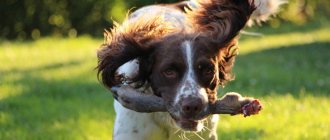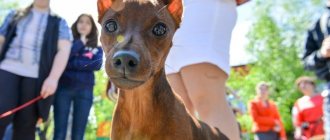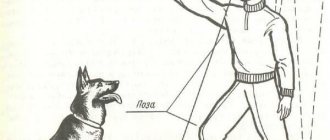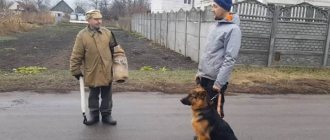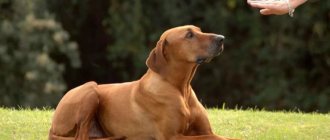Sometimes dogs are expected not only to be friendly and loyal, but also to protect their owners and things. Let's look at how to teach a dog the "Face" command at home. It is possible to train a pet, but it is important to be able to apply knowledge in life. Therefore, a responsible approach and clear understanding are required from the owner. It is important to consider the nature of the animal - if it is uncontrollable, it can be dangerous to others.
It is necessary that the dog knows the commands “Sit”, “Next”, “Come to me”, “Give” and has an easy-going disposition. A pet trained to attack will require special supervision. It will be necessary to always stop unnecessary attempts to protect the owner. Even if the attack is justified, but occurred outside private property, the owner will have to prove it. It is also important to periodically maintain the skill with training.
Why do you need to teach your dog the “face” command?
The “fas” command is used for self-defense in the event of an attack on the owner by an attacker. If the dog is trained to attack on command, his actions in the future can save your life or at least preserve your health.
Also, in the event of theft, with the command “front” the dog will be able to catch up and detain the criminal until you arrive.
Service animals are taught this exercise from childhood, but this skill is also quite learned by pets. The main thing is to approach the training of the animal responsibly, taking into account all the small details.
Precautionary measures
Training is carried out in a fenced area away from passers-by. The assistant’s body must be covered with protective clothing, and his face with a special mask. Only the eyes are left visible. This is necessary to identify emotions.
A harness or halter is put on the animal, since sudden jerks in the collar can lead to injury and suffocation. Attacks are encouraged exclusively on the sleeve. The face, neck and groin should remain off-limits for bites.
Features of training
- Before you start training your pet as a serious command, you need to realize whether you are ready to take on such responsibility, because if you make mistakes in training, it will be difficult to avoid irreversible consequences.
- To avoid the risk of aggression in an animal towards people or animals in everyday life, it is recommended to periodically visit a dog handler so that he, seeing the shortcomings in reality, can help you correct them. If the dog trainer sees that you are training your pet incorrectly, he will direct you in the right direction.
- Not all dogs are capable of learning the “face” command. Training depends not only on the breed of the animal, but also on its psyche and character. You cannot teach the “face” command to a dog with a weak nervous system (such dogs are cowardly and overly emotional). It is strictly recommended to train an aggressive animal with the help of an experienced dog handler, since you yourself can only aggravate the situation.
- Before learning the “Face” command, the dog must know the basics of the general training course. The main thing is that the dog respects the owner and does not violate boundaries, and also clearly understands the meaning of the “fu” and “no” commands.
- It is impossible to learn the "fas" command alone. You will need an assistant in a specialized protective suit.
- In addition to training, do physical training with your pet. Build strength and endurance in your animal, develop muscles. At a minimum, you should take your dog for long, active walks. You can also give your pet trotting and swimming exercises to improve physical fitness.
It is important not to overdo it and adequately dose the load for the animal. Of course, the dog must be healthy.
Practicing a skill in different situations
After the basics have been established, they begin training to assess the situation. The pet is trained to protect not only the owner, but also the rest of the family, as well as their personal belongings. In case the attacker retreats, they are working on pursuit and arrest techniques.
Methods of attack are adjusted depending on the type of weapon. If the attacker has a knife in his hand, then the four-legged defender attacks in the area of the armpit of the occupied hand, and if a gas spray or stun gun, then from the back.
Where to begin
First of all, think about whether your four-legged dog will be able to learn the “face” command. If you have a gentle and soft pet that does not hold any pressure and, if something happens, can get scared and squeeze, it is unlikely that he will be able to really protect you in a moment of danger.
The “Face” command should be taught to dogs with a strong, stable psyche.
Find an open area with a tree or pole to which you can tie your pet. Under no circumstances should the dog be wearing a collar, as during the training process the animal will strongly pull and tear. To keep your pet healthy, wear a harness while training.
Various techniques
There are several methods for teaching your pet the front command yourself.
All of them are trained on a leash.
Method 1
- The dog stands next to the owner on a soft collar or harness.
- The assistant comes out of hiding and begins to sneak up on the animal, bending down and arousing suspicion with his behavior.
- The owner encourages the dog with the command “stranger”.
- Having approached five steps, the assistant turns around and runs away, the dog tries to grab him, the command “Face!” is given.
This technique is well suited for insecure, timid animals. There is no direct interaction with the enemy.
Method 2
- The pet is on a leash, a favorite toy or bone lies nearby, the assistant walks by, pretending to try to grab the thing.
- The dog begins to break from the leash, trying to bite the intruder, pronouncing “fas!”
The method works well with angry, suspicious dogs.
Method 3
- The dog is tied to a post or tree, the owner stands nearby.
- The assistant passes by several times, teasing the dog with a rag and running away, the owner says “stranger.”
- When the pet gets angry, the assistant approaches the owner and pretends that he wants to attack him.
- The owner shouts: “Face!”, pushes the enemy away; if the dog tries to bite, the rag is given to it, and the assistant “runs for his life.”
Method 4
- In the courtyard of a private house, you can stage an attempt to break in by robbers.
- To do this, the assistant makes suspicious noises and rustles behind the fence, tries to look into the yard, opens the gate and sticks his jacket through it.
- Attempts by a pet to grab a thing, barking at a stranger are encouraged by the word “stranger!”
- This lasts no more than five minutes, then the dog is put on a leash, the owner takes it out the gate, and at the command “Face!” begins to pursue the assistant.
You can let the dog catch up with the person and grab the rag or jacket that he leaves behind.
Stages of training
Puppy training
You can start laying the foundation for a puppy from the age of 1.5-2 months. Of course, there can be no talk of any manifestation of aggression, much less an attack.
At this age, it is necessary to work with the puppy to strengthen the prey instinct. To do this, you need to take a toy and act out your pet.
Play a little every day, ending at the most interesting moment of the game. The dog must chase and pull the toy.
It is important to let the dog win in the fight so that he does not lose interest in the activity.
Offer your animal a variety of toys, including all sorts of rags, grips, and whatever your imagination allows.
The pet's grip should be strong enough, that is, he should hold the toy tightly and not intercept it while tugging. To strengthen your grip, make your dog feel more confident by allowing him to win more, and also develop an interest in the game.
It is important to teach the animal the skills of “give” and “fu” - the dog must unquestioningly follow these commands. By the time you reach one year, you can move on to the next stage of training, which involves training an adult animal.
Training an adult dog
Let the dog get acquainted with the territory of the lesson, then take the animal on a leash and tie it to a tree. Make sure your pet is not confused or distracted by anything.
Stand to the side of the animal so that its body is near your left leg. The dog must sit or stand.
Call the assistant - the person involved. Start saying “stranger” in a provocative tone. Even if the dog doesn’t yet know the meaning of the word, this is necessary to create an association with the “fas” command in the future. The word “stranger” will be a signal for the dog to follow the command “front”.
Ask your assistant to move in strange, hesitant movements. The person involved should also take a rag and wave it, moving towards the pet. A tight leash will further provoke the dog to show aggression. If you feel that the dog is tense enough, and the helper has approached close enough, make a sharp lunge forward and give the command “front”. The dog should rush towards the person and tear the rag or protective sleeve. Praise your dog verbally. After a few seconds, command “fu” and take the dog back to the tree. Repeat this several times.
Untie your dog from the tree, but do not let him off the leash. The animal should be near your left leg. Ask your assistant to move 3-5 meters away from you, also moving in a strange way. As soon as the dog tenses up, make a sharp lunge forward, giving the command “front”. The dog must run to the person involved and grab him. After a few seconds, give the command “fu” and take the animal away. Repeat this several times.
Ask the person involved to run away from the dog, and after placing the dog at your left leg, at the moment of tension, lunge forward and give the command “front”. The dog must catch up with the person involved and grab him, after which you come up and give the command “fu”.
Once you are convinced that the dog clearly releases the helper on the “fu” command, you can work without a leash. Train in different environments and under unforeseen circumstances, bringing the situation as close as possible to the real one. Only then will the pet really be able to protect you in the event of a real danger.
Actionable tips
If the animal cannot be trained due to the characteristics of the breed, an alternative should be used:
- You can train an overly friendly dog to bark on a command that only you two understand. When a suspicious person approaches, it’s worth reporting him. Usually this is enough for the person to leave.
- If your pet does not want to be a guard, you can get a second small dog. They are usually sensitive and warn of approaching danger. Then the pet will also react by barking and scare the ill-wisher with its appearance.
A dog should not be turned into a dangerous weapon. Otherwise, the dog will become a threat to others. It is important to realize your own responsibility for your pet’s actions.
Possible mistakes
- Continuation of work if the dog begins to show cowardice or uncertainty. Do not work with a pet who is not confident, otherwise, with the wrong approach, you will only aggravate the situation. You must work on the animal's stability before you begin teaching the "face" command.
- Manifestation of excessive emotionality. Do not scream or make too loud or emotional sounds, otherwise the dog will regard this as panic and will not show the desired reaction. You must act confident.
- The pronunciation of the command “alien” is just like that . Don't make your pet nervous for no reason. If you tell your dog “stranger” for fun, it may begin to show aggression towards others. In addition, over time, the pet will get used to this word and begin to ignore it.
Development of interception
The trainer holds the dog on a short leash. The assistant teases him at this time, then runs away. Next, the dog handler gives the command “Face”, and together with the dog they chase the assistant. When there is a small distance between the dog and the runner, the latter turns half a turn and exposes his sleeve to the dog.
If the animal grabs it, then the assistant pulls it a little closer to itself in order to strengthen the grip. He then takes a couple of steps closer to the dog to stop the pull, and raises his other sleeve over the dog's head to strike. The dog, seeing danger approaching, intercepts it. You need to repeat the exercise three times. As soon as the dog handler pronounces the command “Stop,” the fight stops. After which the dog is calmed down, encouraged and taken a few steps away from the “enemy”.
Popular question
Will the dog become aggressive towards others?
If you follow all the rules of command training, the dog will not rush at others for no reason.
For prevention, it is recommended to periodically visit a dog handler. Also, if you notice on walks that the dog begins to at least become wary at the sight of passers-by, distract the dog with food or toys.
In this case, you also need to visit a specialist to work out this point.
Conditions of detention
A dog raised to protect the home and family members must be fed properly and kept in proper conditions. Choose balanced food for the animal. You cannot fatten the animal; it must always be in shape.
It is important to monitor the animal’s health, do all vaccinations on schedule, and regularly show your pet to the veterinarian.
Protection of family members
After practicing the voice orders “fas” and “fu,” all family members, including children, are involved in the training process. The animal must learn to protect them too. This will protect loved ones from being attacked by a pet.
Briefly about the main thing
- The “Face” command can only be taught to healthy animals with a strong nervous system. The dog should not be shy or overly emotional.
- From the age of 2 months, puppies are taught to grab and retrieve toys. Upon reaching a year, the instinct of aggression in pets is checked.
- Tie the dog to a tree and ask the helper to move strangely, waving his arms and a rag. Say “stranger”, after which, if you feel that the dog is tense, make a sharp lunge forward and command “front”. As soon as the pet rushes towards the person involved, after a couple of seconds give the command “fu”. Repeat this several times.
- Untie the dog from the tree and repeat the same steps, but only at a distance of 3-5 meters from the person involved. Reinforce the command with repetitions.
- Ask the person involved to run away from the dog, then command “front”. As soon as the dog has grabbed the “criminal”, go up to the dog and command “fu”.
- Train the skill in different environments and under unforeseen circumstances so that the dog learns to protect its owner in any situation.
Learning the “front” command is a long and difficult process, but in the end, with the right approach, you will definitely come to the desired result.
You can share your training experience in the comments or ask a question. Good luck!
Requirements
Proper training will require strict fulfillment of the requirements, close psychological contact with the dog and training.
The first thing the owner must understand is the command “Face!” when performed correctly, it leads to an animal attacking another person, so it should be used only as a last resort.
Required skills before learning the command “Face!”
First of all, you need to teach the shepherd the rules of normal behavior on the street and with the owner, otherwise it will show anger at its own discretion. Under no circumstances should you command “Fas!” on friends, relatives, or passers-by who do not pose a threat.
Teach your German Shepherd the command “Fast!” possible at any age, starting from five months, but first you need to complete a general “Obedience” training course, which includes a number of commands and exercises:
- Commands “Sit!”, “Lie down!”, “Stand!” help control the dog when moving around the city;
- "Give!" — prevents aggression towards the owner when trying to take away a treat or toy;
- "Ugh!" (or any analogue) – cancels the current activity, and ideally, the attack;
- "Place!" - a difficult exercise for such an active dog as a German Shepherd, which increases endurance.
Unable to obey, a dog can use its anger against its owner or others. It is extremely difficult to teach an adult dog the basics of behavior, so initial training should be started from the first days of communication with the purchased puppy (according to FCI standards, the legal sale of a puppy with documents is possible from two months).
Psychological contact
To successfully train your pet and get satisfactory results, you need to establish psychological contact. If a dog has a strong sense of attachment to its owner, it will be able to concentrate its attention on it, and will quickly perceive information and remember its actions.
A close emotional connection will also ensure that the pet, without prior training, will be ready to protect the owner, but it is still better for this process to be controlled.
Professional dog trainer or lessons at home
There are owners who are ready to entrust the training process to a professional. Now you don’t have to bring your pet to a separate area. A dog trainer can come to your home and conduct training in a comfortable environment for the dog.
One lesson is not enough for the dog to learn the command. A whole course is required, which often includes behavior correction. The cost of the lesson depends on the characteristics of the breed and the content of the program. The standard course includes training in basic commands, including “fas”.
Important! The number of classes depends on the intellectual characteristics of the dog. The higher they are. The fewer lessons she will need to learn a new skill.
The cost of one lesson for representatives of small and decorative breeds with a dog handler visiting your home in the regions of the Russian Federation is about 1000 rubles, in Moscow and the Moscow region the price is higher - 1600-1800 rubles. The price of one lesson for dogs of medium and large breeds starts from 1,500 rubles. and can reach 3,000 rubles.
Training of defensive commands
How to teach
Stray dogs are unpleasant surprises that appear suddenly during a walk and can cause many unpleasant moments.
Any mongrel that is considered stray, purebred pets whose owners got rid of them in this way, will never rush at a person if a dog is walking next to him. Animals want to sort this out for themselves, so the mere presence of a pet protects a person from an attack by a stray dog. But the dog can suffer from bites from large, vicious animals, so if during a walk the owner notices several dogs in the distance huddled together in a pack, it is better to change the walking route or arm yourself with several stones.
One homeless dog often stands timidly on the sidelines, preparing to run away, and if you want to arouse aggression in your pet, it is enough to pretend that you are about to throw a stone and say “stranger!” The dog will jump to the side, and the pet will understand that it was he who drove the enemy away.
In the future, when it becomes necessary to show aggression, it is enough to say a command, and the dog will bark on a leash. This does not mean that she will run up and bite the enemy. Most likely, the dog will continue to bark at the stranger or other people’s animals without approaching them. Many adult dogs need to be taught to bite!
But you cannot pit your dog against stray animals, it is not humane, and there is a risk that your pet may pick up some kind of infection from a stray animal. Rabies in dogs is dangerous and is deadly for both animals and humans.
What the professionals say
Dog trainers say that not every dog can be trained. There are dogs in which the hunting instinct is genetically embedded, for example, the shepherd, and such dogs are easier to train.
It is believed that to train a dog must:
- Don't be overly friendly and affectionate. On the contrary, animals that are at least wary of the presence of strangers are more valued in this regard;
- be physically strong and active;
- possess qualities such as courage, confidence and restraint.
Important! Of course, it is best to entrust dog training to professionals in their field. But this does not mean that you will not be able to cope with this on your own, it will just take a little longer.
It is necessary to train the dog with the involvement of strangers in order to be able to practice the command.
Before teaching your four-legged friend the “Face” command, you need to think about your actions and possible consequences. Having decided to do this, you should follow all the rules and basics of successful training. Only then can you achieve the desired result.






